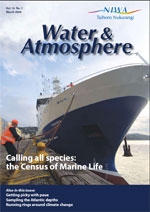PDF of this article (183 KB)



PM launches major Antarctic biodiversity voyage
Though the ship was heading into the most extensive sea ice seen in the Ross Sea for 30 years, it was a sunny day in late January when Prime Minister Helen Clark farewelled the 26 scientists and 18 crew onboard RV Tangaroa. Their mission: a 50-day voyage to survey Ross Sea biodiversity, the first part ofthe NZ IPY-CAML project, New Zealand’s largest involvement in two major international research programmes, International Polar Year (IPY) and the Census of Antarctic Marine Life (CAML).
The team, which includes 19 NIWA scientists, is surveying life forms ranging from the microscopic to the mega-sized – and the interactions between them – across a range of environmental and geographic gradients in the Ross Sea region. The surveyincludes habitats ranging from the ice-scoured shelf to offshore seamounts and the abyss. The team is sampling and filming life from the sea surface to the seabed, at depths of up to 4000 m, in areas not previously explored.
Data will be analysed over the next three years and taxonomists expect to find many new species among the samples. The project will help to understand the Ross Sea biodiversity and its ecosystem roles. The results will also help in the management of the toothfish fishery, and provide baseline information to help monitor the biological effects of climate change in the region.
The voyage is funded by Land Information New Zealand, partly under the Ocean Survey 20/20 programme, with Ministry of Fisheries as the lead partner. LINZ has contracted NIWA tolead the voyage, which involves scientists from NIWA, MFish, Te Papa, Victoria and Waikato Universities, and the US and Italy.
For further information, contact: Dr Fiona Proffitt, 0-4-386 0546, [email protected]
To follow the voyage’s progress, see: www.niwascience.co.nz/rc/antarctica/ipy-caml Educational material can be found at: www.sciencelearn.org.nz/
Update from IceCUBE
Not many people are aware of the incredible diversity and abundance of life under the sea ice in coastal Antarctica. The Ross Sea coastline spans several degrees of latitude – from McMurdo Sound in the south, where Scott Base is situated at around 77° S, to Cape Adare in the north (72° S). With this change in latitude there are variations in environmental factors that have big influences on seafloor communities, such as water temperature, the amount of direct disturbance to the seafloor by ice (including anchor ice and icebergs), and sea ice (how much, how thick, how long it hangs around). These different sea-ice conditions affect how much light there is for microscopic plants (such as phytoplankton) to grow, which in turn affects how much food is available for organisms living on the seafloor.
For several years now, NIWA’s IceCUBE (Coastal Underwater Benthic Ecosystems) research programme has been investigating these benthic organisms and their habitats, learning more about feeding relationships of key species and organism–environment interactions at different spots along the Ross Sea coast. Last November, the team visited Granite Harbour at the northernmost point of McMurdo Sound, where divers sampled the seafloor using video and core sampling, and collected specimens that were later dissected and analysed to help figure out what they are eating. (For more about that expedition, see 'Under the ice with Rod Budd'.)
We’ll add the information from Granite Harbour to data collected from other locations along the coastline in previous years. Through this sampling and analysis we’re building a good understanding of how these ecosystems work, and this will help us to predict the likely effect of climate change and other impacts (such as fishing) on this unique and special environment. This research is supported by FRST, MFish, and Antarctica New Zealand.
For further information, contact: Dr Vonda Cummings, 0-4-386 0602, [email protected] or see: www.niwascience.co.nz/rc/antarctica/icecube
